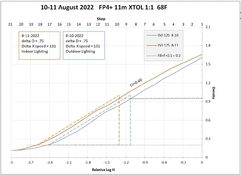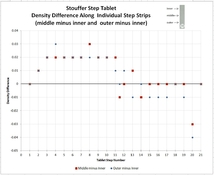Stephen Benskin
Member
Stephen, thanks for your comments. I applied a bit of opaque tape to the step wedge, which left a spot on my negative that was not exposed. That patch on my negatives has measured 0.1 or 0.11 consistently. I erred in taking measurements from the rebate when the blank patch was available. Using the blank patch to compute FB+F+0.1 (= 0.2), rather than using the rebate for the FB+F+0.1 (=0.27) measurement, causes the anomalous 1/2 stop shift in the ISO triangle to disappear (Bill Burke's post #6). The plot below shows the relocated ISO triangle with base at 0.2 density units.
View attachment 310391
My apologies to the respondents to this post for dumb errors. I have learned more than a bit though, so thanks. Lesson not the least: the initial topic - could I use an systematic analysis of developed negatives to derive a more appropriate film speed for future shooting - may be more relevant once I have greater mastery of basic ideas and practice.
I'm not convinced whether attempting to determine film speed using anything other than a calibrated sensitometer is much better than an approximation which can be accomplished by doing a little shooting. However, the advantage you have with testing using curves is in determining a developmental model and in comparing emulsions. You keep referring to your triangle as an ISO triangle except you're appear to be using different dimensions. ISO is Δ1.30 log-H by Δ 0.80 log-H. Associating Zones and curves can also be problematic, especially for beginners. For one, the relationship between speed point and the metered exposure point is Δ1.0 log-H and not the Δ1.20 log-H of the Zone System. What does that say about the determination of film speed? Two, it also tends to suggest that the Zones are associated with specific densities.
I highly recommend the link to the papers in the Delta-X Criterion thread you started. A good overview of the papers are the chapters on sensitometry and tone reproduction in The Theory of the Photographic Process 3ed edition. If you've begun reading Photographic Materials and Process then you are off to a good start.
Concerning the Phil Davis influence I see in your tests. He mistakenly continued to apply a fixed density to determine speeds with films processed to higher or lower gradients that indicated in the ISO standard. According to one of the papers available in the link, Safety Factors in Camera Exposure, "The fractional-gradient speed criterion (and its approximate equivalent, the simpler ∆X speed criterion) will continue to be useful as a supplement to the fixed-density speed criterion when an evaluation is desired of the effective picture-taking speeds of films that have been developed to average gradients higher or lower than the proposed standard average gradient. The fixed density criterion tends to underrate films that are developed to a lower average gradient and to overrate films that are developed to a higher average gradient."







